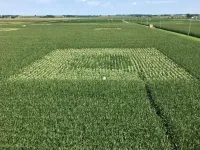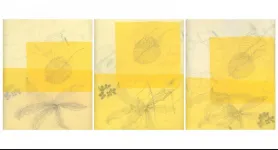(Press-News.org) RIVERSIDE, Calif. -- A team led by a biomedical scientist at the University of California, Riverside, has developed a new RNA-sequencing method-- "Panoramic RNA Display by Overcoming RNA Modification Aborted Sequencing," or PANDORA-seq -- that can help discover numerous modified small RNAs that were previously undetectable.
RNA plays a central role in decoding the genetic information in DNA to sustain an organism's life. It is generally known as the intermediate molecule used to synthesize proteins from DNA. Cells are full of RNA molecules in complex and diverse forms, two main types being ribosomal RNA, or rRNA; and transfer RNA, or tRNA; which are involved in the synthesis of proteins.
Small RNAs play essential roles in health and diseases, including cancer, diabetes, neurological diseases, and infertility. Examples of small RNAs are microRNA; piwi-interacting RNA, or piRNA; and tRNA-derived small RNA, or tsRNA. Small RNAs can get modified by chemical groups and thus acquire new functions.
The development of high-throughput RNA sequencing technologies -- useful for examining the quantity and sequences of RNA in a biological sample -- has uncovered an expanding repertoire of small RNA populations that fine-tune gene expression and protect genomes.
"PANDORA-seq can be widely used to profile small RNA landscapes in various physiological and disease conditions to facilitate the discovery of key regulatory small RNAs involved in these conditions," said Qi Chen, an assistant professor of biomedical sciences in the UCR School of Medicine, who led the study published today in Nature Cell Biology. "Modified small RNAs wear an 'invisibility cloak' that prevents them from being detected by traditional RNA-sequencing methods. How many such modified RNAs are there? What is the origin of their sequences? And what exactly is their biological function? These are questions PANDORA-seq may be able to answer."
PANDORA-seq employs a stepwise enzymatic treatment to remove key RNA modifications, which then takes off the invisibility cloak used by the modified small RNAs.
"PANDORA-seq has opened Pandora's box of small RNAs," said Tong Zhou, a bioinformatician at the University of Nevada, Reno School of Medicine and a co-corresponding author of the study. "We can now dance with these once invisible partners in the RNA ballroom."
According to Chen, PANDORA-seq uncovers a surprising small-RNA landscape that is dominated by tsRNAs and rRNA-derived small RNAs, or rsRNAs, rather than microRNAs, which were previously believed to dominate many mammalian tissues and cells.
"With PANDORA-seq, we found unprecedented microRNA/tsRNA/rsRNA dynamics when somatic cells are reprogrammed to induced pluripotent stem cells, which are generated by adult cells and have properties similar to those of embryonic stem cells, making them capable of differentiating into all cell types of the body," said Sihem Cheloufi, an assistant professor of biochemistry at UCR and a co-corresponding author of the paper. "Some tsRNAs and rsRNAs can impact protein synthesis and even affect embryonic stem cell lineage differentiation in embryonic stem cells."
Chen explained the current best-studied classes of small RNAs in mammals are microRNAs, which are abundant in mammalian somatic cells and control the kind and amount of proteins the cells make; and piRNAs, which are mainly expressed in the testis and modulate germ cell development.
"Currently, these small RNAs can be comprehensively profiled by high-throughput methods such as RNA sequencing," he said. "However, the widely used small RNA sequencing protocols have intrinsic limitations, which prevent certain modified small noncoding RNAs from being detected during RNA sequencing. PANDORA-seq overcomes these limitations."
Junchao Shi, a doctoral student working in Chen's lab and the research paper's first author is enthusiastic about the use of PANDORA-seq.
"The new method could revolutionize the view of small RNA landscapes," he said. "Frankly, all previous studies using traditional RNA-sequencing may now need to be revisited."
Cheloufi said the team now wants to understand how tsRNA/rsRNA are generated, how they function in stem cells, and how they orchestrate cell fate decisions during development.
"Answers to these questions are timely to develop diagnostic tools, identify therapeutic targets, and advance regenerative medicine," she said.
While developing PANDORA-seq, Chen was reminded of the parable of the blind men and the elephant, which teaches truth is only revealed when various parts come together.
"We sometimes forget the big picture, being focused on just a small part of it," he said. "Perhaps the only way to arrive at total truth -- the big picture -- is to push against our boundary of knowledge and confirm the revealed truth with newly devised technology."
"It is fascinating to observe down the lenses of a microscope in the lab the profound cell fate change during cellular reprogramming and differentiation," said Reuben Franklin, a doctoral student in Cheloufi's lab and a coauthor on the study. "But PANDORA-seq allows us to eavesdrop on the molecular players during these processes."
INFORMATION:
Chen, Cheloufi, Shi, Zhou, and Franklin were joined in the research by scientists at various institutions in the United States, United Kingdom, and China.
Chen and Cheloufi were funded by the National Institutes of Health and UCR startup funds.
The title of the paper is "PANDORA-seq expands the repertoire of regulatory small RNAs by overcoming RNA modifications."
The University of California, Riverside is a doctoral research university, a living laboratory for groundbreaking exploration of issues critical to Inland Southern California, the state and communities around the world. Reflecting California's diverse culture, UCR's enrollment is more than 25,000 students. The campus opened a medical school in 2013 and has reached the heart of the Coachella Valley by way of the UCR Palm Desert Center. The campus has an annual statewide economic impact of almost $2 billion. To learn more, email news@ucr.edu.
Although stratospheric ozone protects us by filtering out the sun's ultraviolet radiation, tropospheric ozone is a harmful pollutant. A new study has shown that ozone in the lower layers of the atmosphere decreases crop yields in maize and changes the types of chemicals that are found inside the leaves.
Ozone is formed when nitrous oxide, released from industries and tail pipes of cars, is broken down by sunlight and chemically reacts to form ozone. Researchers at the University of Illinois Urbana-Champaign have been studying the effects of ozone pollution on crops for over 20 years at a unique facility where crops can be grown under real-world farm ...
WINSTON-SALEM, N.C. - April 5, 2021 - According to the American Cancer Society, a noninvasive breast cancer called ductal carcinoma in situ (DCIS) accounts for approximately one of every four new breast cancer cases in the United States. If left untreated, DCIS has the potential to evolve into invasive cancer, so many patients choose to have breast-conserving surgery or mastectomy after a diagnosis.
However, obtaining clear or negative margins -- no cancer cells in the outer edge of removed tissue -- is critical to mastectomy success as positive margins are associated with higher rates of recurrence.
A new study from Wake Forest School of Medicine suggests removing ...
A new study published in Indoor Air provides design-based solutions on how to best use ultraviolet germicidal irradiation (UVGI) to disinfect occupied rooms without harming individuals. This research was conducted by Dorit Aviv, assistant professor of architecture and director of the Thermal Architecture Lab at the University of Pennsylvania Stuart Weitzman School of Design, Penn visiting scholar Miaomiao Hou, and Jovan Pantelic, an air quality expert at Katholieke Universiteit Leuven.
Ultraviolet germicidal irradiation (UVGI) devices use short-wavelength ultraviolet ...
Palmer Amaranth is a high-impact agronomic weed species that has cost the United States agriculture industry billions of dollars since its discovery outside of its native range in the southwestern U.S. and northwestern Mexico. Over the last 20 years, it has moved further north, and now poses a major threat to corn, soybean, and cotton growers across the south and Midwest regions of the United States.
It is not legal to sell any kind of seed in Minnesota if the seed lot contains Palmer Amaranth. The problem is this particular invasive species--which has shown potential to wipe out up to 91% of corn yields, 68% of soybean yields, and 54% of cotton yields-- is difficult to visibly distinguish from ...
Scientists create stable nanosheets containing boron and hydrogen atoms with potential applications in nanoelectronics and quantum information technology.
What's thinner than thin? One answer is two-dimensional materials -- exotic materials of science with length and width but only one or two atoms in thickness. They offer the possibility of unprecedented boosts in device performance for electronic devices, solar cells, batteries and medical equipment.
In collaboration with Northwestern University and the University of Florida, scientists from the U.S. Department of Energy's (DOE) Argonne National Laboratory report in Science ...
How do we become a complex, integrated multicellular organism from a single cell?
While developmental biologists have long researched this fundamental question, Stanford University biologist and HHMI investigator Dominique Bergmann's recent work on the plant Arabidopsis thaliana has uncovered surprising answers.
In a new study, published April 5 in Developmental Cell, led by Bergmann and postdoctoral scholar Camila Lopez-Anido, researchers used single-cell RNA sequencing technologies to track genetic activity in nearly 20,000 cells as they formed the surface and inner parts of an Arabidopsis leaf. Through this highly detailed technique, the researchers captured ...
PHILADELPHIA - A team led by scientists at the Perelman School of Medicine at the University of Pennsylvania has illuminated the functions of mysterious structures in cells called "nuclear speckles," showing that they can work in partnership with a key protein to enhance the activities of specific sets of genes.
The discovery, which will be published on April 5 in Molecular Cell, is an advance in basic cell biology; the key protein it identifies as a working partner of speckles is best known as major tumor-suppressor protein, p53. This avenue of research may also lead to a better future understanding of cancers, and possibly better cancer treatments.
"This study shows that nuclear speckles work as major regulators of gene expression, and suggests that ...
UNIVERSITY PARK, Pa. -- Approximately 40,000 children in the United States may have lost a parent to COVID-19 since February 2020, according to a statistical model created by a team of researchers. The researchers anticipate that without immediate interventions, the trauma from losing a parent could cast a shadow of mental health and economic problems well into the future for this vulnerable population.
In the researchers' model, for approximately every 13th COVID-related death, a child loses one parent. Children who lose a parent are at higher risk of a range ...
CHICAGO - A new study shows that youth arrested as juveniles with psychiatric disorders that remain untreated, struggle with mental health and successful outcomes well beyond adolescence.
Research from Northwestern Medicine shows nearly two-thirds of males and more than one-third of females with one or more existing psychiatric disorders when they entered detention, still had a disorder 15 years later.
The findings are significant because mental health struggles add to the existing racial, ethnic and economic disparities as well as academic challenges from missed school, making a successful transition to adulthood harder to attain.
"Kids get into trouble during adolescence.Those from wealthier families also use drugs and get into fights. But these situations are most often ...
What The Study Did: Researchers estimated and projected the number of children in the United States affected by the death of a parent from COVID-19.
Authors: Rachel Kidman, Ph.D., of Stony Brook University in Stony Brook, New York, is the corresponding author.
To access the embargoed study: Visit our For The Media website at this link https://media.jamanetwork.com/
(doi:10.1001/jamapediatrics.2021.0161)
Editor's Note: The article includes conflict of interest disclosures. Please see the article for additional information, including other authors, author contributions and affiliations, conflict of interest and financial disclosures, and funding and support.
INFORMATION:
Media advisory: The full study is linked to this news release.
Embed this link to provide your readers ...



